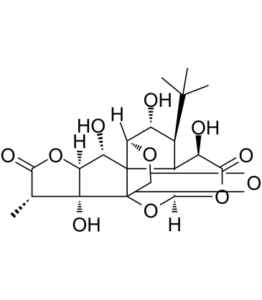Ginkgolide C (BN-52022)
This product is for research use only, not for human use. We do not sell to patients.

For small sizes, please check our retail website as below: www.invivochem.com
| Size | Price | Stock |
|---|---|---|
| 250mg | $450 | Check With Us |
| 500mg | $750 | Check With Us |
| 1g | $1125 | Check With Us |
Cat #: V21592 CAS #: 15291-76-6 Purity ≥ 98%
Description: Ginkgolide C (BN-52022) is a naturally occuring product isolated from Ginko and a GABA-A receptor, α-1 GlyR, and PAF receptor antagonist.
Top Publications Citing Invivochem Products
Publications Citing InvivoChem Products
Product Promise

- Physicochemical and Storage Information
- Protocol
- Related Biological Data
- Stock Solution Preparation
- Quality Control Documentation
| Molecular Weight (MW) | 440.40 |
|---|---|
| Molecular Formula | C20H24O11 |
| CAS No. | 15291-76-6 |
| SMILES Code | C[C@@H]1C(O[C@H]2[C@@H]([C@]34[C@@H]5OC([C@@]3([C@@]12O)O[C@@H]6OC([C@@H]([C@]46[C@H](C(C)(C)C)[C@H]5O)O)=O)=O)O)=O |
| Synonyms | BN-52022; BN52022; BN 52022; Ginkgolide C |
| Protocol | In Vitro | Ginkgolide C (3-100 μM) has no significant effect on 3T3-L1 cell viability, but suppresses adipogenesis in 3T3-L1 cells followling 24 h treatment. Ginkgolide C (10-100 μM) significantly suppresses lipid accumulation compared with the control group and also significantly promotes glycerol release in 3T3-L1 adipocytes. Ginkgolide C suppresses PPAR-α and PPAR-γ expression and decreases C/EBPα, C/EBPβ, and SREBP-1c expression in differentiated 3T3-L1 adipocytes. In addition, Ginkgolide C (3-100 μM) suppress adipogenesis-related protein (FAS, LPL, and aP2) and mRNA expression in a dose-dependent manner in differentiated 3T3-L1 adipocytes. Ginkgolide C (3-100 μM) also significantly promotes Sirt1 production and increases phosphorylation of AMPKα and ACC-1 in a concentration-dependent manner. |
|---|
These protocols are for reference only. InvivoChem does not
independently validate these methods.
| Solvent volume to be added | Mass (the weight of a compound) | |||
|---|---|---|---|---|
| Mother liquor concentration | 1mg | 5mg | 10mg | 20mg |
| 1mM | 2.2707 mL | 11.3533 mL | 22.7066 mL | 45.4133 mL |
| 5mM | 0.4541 mL | 2.2707 mL | 4.5413 mL | 9.0827 mL |
| 10mM | 0.2271 mL | 1.1353 mL | 2.2707 mL | 4.5413 mL |
| 20mM | 0.1135 mL | 0.5677 mL | 1.1353 mL | 2.2707 mL |
The molarity calculator equation
Mass(g) = Concentration(mol/L) × Volume(L) × Molecular Weight(g/mol)
Mass
=
Concentration
×
Volume
×
Molecular Weight*
The dilution calculator equation
Concentration(start)
×
Volume(start)
=
Concentration(final)
×
Volume(final)
This equation is commonly abbreviated as: C1 V1 = C2 V2
Concentration(start)
C1
×
Volume(start)
V1
=
Concentration(final)
C2
×
Volume(final)
V2
Step One: Enter information below
Dosage mg/kg
Average weight of animals g
Dosing volume per animal µL
Number of animals
Step Two: Enter the in vivo formulation
%DMSO
+
%
+
%Tween 80
+
%ddH2O
Calculation Results:
Working concentration:
mg/ml;
Method for preparing DMSO master liquid:
mg
drug pre-dissolved in
µL
DMSO(Master liquid concentration
mg/mL)
,Please contact us first if the concentration exceeds the DMSO solubility of the batch of drug.
Method for preparing in vivo formulation:
Take
µL
DMSO master liquid, next add
µL
PEG300, mix and clarify, next add
µL
Tween 80,mix and clarify, next add
µL
ddH2O,mix and clarify.
Note:
- (1) Please be sure that the solution is clear before the addition of next solvent. Dissolution methods like vortex, ultrasound or warming and heat may be used to aid dissolving.
- (2) Be sure to add the solvent(s) in order.




































